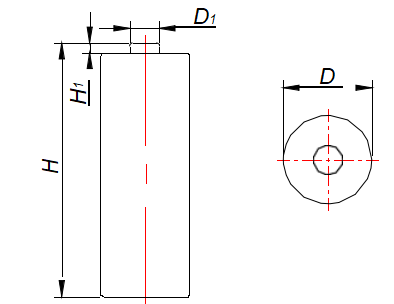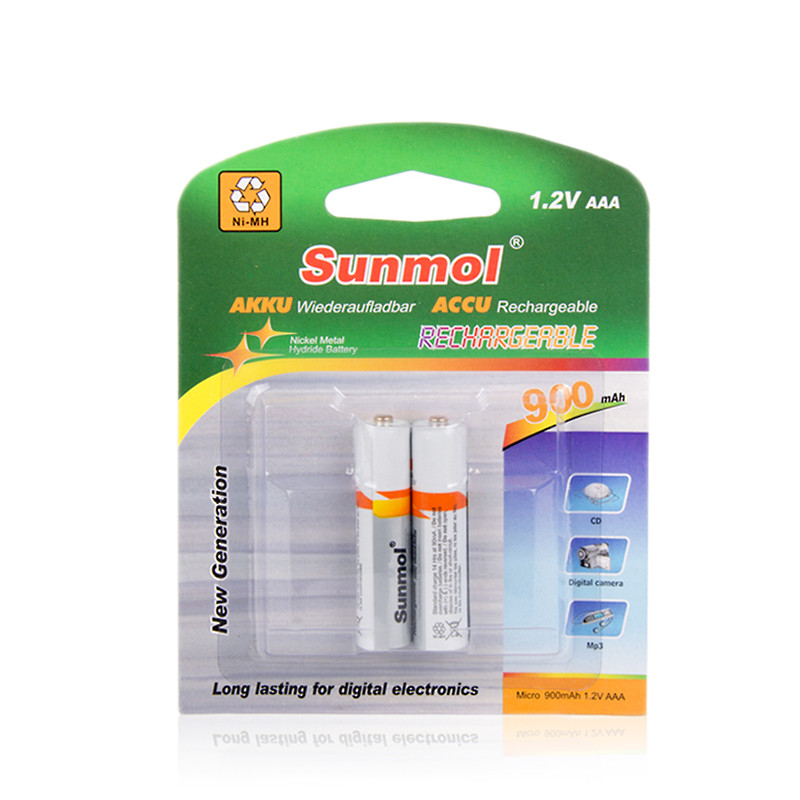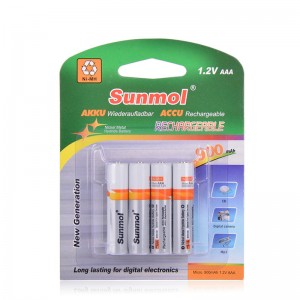Ni-MH FR6 FR03 AA AAA rechargeable battery
Introduction
| Model: | H-AA1500HT |
| Nominal Voltage | 1.2 V |
| Nominal | 1500 mAh |
| Minimum | 1500 mAh/0.2C |
| Standard charge rate | 150 mA × 16h |
| Rapid charge rate | 1500 mA ×72min (-ΔV= 5mV) |
| Value of dT/dt (for reference only) | 1to 2 /min |
| Operating temperature range | Humidity: +65%± 20 |
| Standard charge | 0 to +45 (32 to 113) |
| Rapid charge | +10 to+ 45 (32 to 104) |
| Discharge | -20 to +65 (14 to 149) A12 |
| Storage temperature range | Humidity : +65%±20% |
| Within 1 year | -20 to +35 (-4 to 95) |
| Within 6 months | -20 to +45 (-4 to 113) |
| Within 1 month | -20 to +55 (-4 to 131) |
| Within 1 week | -20 to +65 (-4 to 149) |
All rapid charge methods should be discussed with our engineer
We stipulate to charge less than 40% fully power for delivery, if the charge is more than 40%, the battery has a certain latent risk. For the charge requirement is over 40% which caused quality problem, we do not undertake any responsibility.
Our battery guarantee time: 12 months
During storage period the batch battery is requested by the 40% electric charge, the battery storage surpasses 3 months, we suggest charge 40% every 3 months .
Measurement & Dimensions
To see the drawing:
| D |
13.5~14.2mm |
| H |
47.5~48.5mm |
| D1 |
≤8.1mm |
| H1 |
>0.3mm |

Performance Testing
1.1. TEST CONDITIONS
1.1.1 The battery to be tested is the product within one month after being received by customer.
1.1.2 Ambient conditions:
Temperature +20 ±5
Humidity +65%±20%
4.2 Testing Tools
4.2.1 Voltage meter:
0.5 level or higher as required in IEC51/IEC485. Internal impedance exceeds 10KΩ/V.
4.2.2 Current meter:
0.5 level or higher as required in IEC51/IEC485. Internal impedance should be less than 0.01Ω/V(including wires).
4-2.3. Micrometer caliper:
With precision of 0.02mm.
4-2.4. Internal impedance meter:
Alternating current of 1000HZ, connector measuring equipment with sin wave of 4. 4-2.5: Impedance loaded meter:
Value of impedance is with +5% error allowed (including external wires).
4.2.6 Incubators Accuracy ±2
|
Item |
Test Method |
Benchmark |
| 1.Appearance: | eyeballing |
batteries shall be free from any stains; scratches or deformations, which may reduce the commercial value when visually inspected |
| Size: | caliper measurement。 | The size shall comply with thespecified size as the attached drawing |
| Insulate impedance | measured with a Megger overpack and battery electrode between the degree ofinsulation。 | outer sleeve shall exceed 10 MΩ。 |
| Weight | using disk-scale measurement。 | approximate 25.5 g。 |
| Charge Voltage | Following a period of discharge at 0.2CmA down to a terminal voltage of 1.0V, standard charge, the cell or battery shall be checked at 5 minutes beforefinish charging。 | The voltage shall be less than 1.6 V。 |
| Open circuit voltage: (O.C.V.) | Following a standard charge period, the open circuit voltage of the cell or batteryshall be checked within 1 hour.。 | The O.C.V. shall exceed 1.25 V |
| Closed circuit voltage: (C.C.V.) | Following a standard charge period, the closed circuit voltage of the cell or battery shall be checked with a 0.86 Ω per cellload within 1 hour。 | The C.C.V. shall exceed 1.2 V。 |
| Internal impedance | Following a standard charge period, the internal impedance of the cell or batteryshall be checked at 1000Hz within 1 hour | The internal impedance shall not be more than 35mΩ。 |
| Capacity | Following a standard charge period, the cell shall be stored for a period of 1 hour. The capacity shall be equal or more than minimum capacity when discharged at0.2C mA down to a terminal voltage of 1.0V;
The capacity returned might not initially attain the specified value following the first charge –discharge cycle. In this event, the test may be repeated a further two or three times to attain the minimum capacity。 |
The capacity is greater than or equal to the minimum capacity。 |
| High DrainDischarge | To discharge by 1.0C to 1.0V within 1 hour after standard charge。 | ² The Capacity is higher than orequal to 54 min。 |
| Over-charge | Following a period of discharge at 0.2C mA down to a terminal voltage of 1.0V, standard charge and then charge for 48hrs at 0.1C mA. The capacity of the cell or battery shall not be less than the rated capacity when discharged at 0.2C Ma |
² It shall not be externally deformed and no leakage of electrolyte in liquid form shall be observed.。 |
| Over-discharge | Following a period of discharge at 0.2C mA down to a terminal voltage of 1.0V, combine the cells with a 0.86 Ωper cell load. After stored for a period of 24 hours, standard charged and thendischarge at 0.2C mA。 | ² the cell or battery shall not be externally deformed and no leakage of electrolyte in liquid form shall be observed, and the subsequent capacity shall not beless than 80% of rated capacity。 |
| Self discharge | Following a period of discharge at 0.2C mA down to a terminal voltage of 1.0V, standard charge and then the cell or battery shall be stored for 28 days below 20 。 | ² The subsequent capacity shall not be less than 60% of rated capacity when discharged at 0.2C mA。. |
| Cycle Life | ² Based on clause 7.4.1.1, IEC61951-22003。 | ² The charge-discharge cycles shallexceed 500 times。 |
| Humidity |
Standard charge and store for 14 days under the following storage conditions: 33 ±3 (91.4 ±5.4 ) , Relative humidity of 80%±5%. (Salting is permitted).。 |
² No leakage of electrolyte in liquid form shall be observed。 |
| Vibration | Store the cell or battery more than 24 hours after standard charge, following vibration tests over an amplitude of 4 mm (0.1575 inches) at a frequency of 16.7 Hz(1000 cycles per minute) and repeated through any axes during 60mins。 | ² The subsequent fluctuation of open circuit voltage and internal impedance shall be less than 0.02 V and 5 mΩ respectively, and the cell or battery shall not be externally deformed and no leakage of electrolyte in liquid form shall be observed. 。 |
| Free falling: (Drop) | Store the cell or battery more than 24 hours after standard charge, following a drop test from 450mm (17.717 inches ) on to a hard-wood board in a vertical axis 2 times on each of 2 mutually perpendicular axes, | The subsequent fluctuation of open circuit voltage and internal impedance shall be less than 0.02 V and 5mΩ respectively, and the cell or battery shall not be externally deformed and no leakage of electrolyte in liquid form shall be observed.。 |
| Short-circuit testing | to store it for 1 hour after standard charged, and to make positive and negative electrode short circuit with a wire with the section 0.75mm2min and shortest length, the short-circuit time is 1 hour | It shall not explode during or at the end of a 1 hour short-circuit test. However, leakage of electrolyte, external deformation or outer sleeve cracking is permitted.。 |
| Safety Valve Performance (Over dis- charging) | to be discharged with 1C mA for 5 hours | The safety valve must start normally , battery without breakage;Leakage, distortion andouter package breakage are allowed |
| Safety Valve Performance (over charging) | to be charged with 1C mA for 5 hours | No explosion, but leakage, distortion and out package breakage are allowed |
| To discharge at low temperature | to be stored for 24 hours at 0 ±2 , and discharged at 0.2C mA at 0 ±2 。 | discharge duration shall exceed 3 hour and 30 min。 |
| To discharge at high temperature | to be stored for 24 hours at 70 ±2 , and discharged at 0.2C mA at 70 ±2 。 | discharge duration shall exceed 3 hour and 30 min。 |
The transportation and storage
Transportation
In the transportation process the battery should maintain at clean, dry, and the well ventilated environment, and prevents the fierce vibration, the impact or the extrusion, prevents to be exposed to the sun and rain. Battery could be transported by automobile, train, steamboat ,airplane and other transportation vehicle .
Storage
5.2.1 Battery must be stored at -20 ~ +35 , (It is best at 15 ~ +25 ) and put in the clean, dry and ventilated place with relative humidity 85% max.. It must be kept away from corrodent substance, fire hazard and heat resource.
5.2.2 Storage placement way
The packed battery in a carton stack less than 5 layers, to guarantee that between the cell box has the good air circulation condition, please maintain between the carton above 5~10 cm distance, which prevents the safety incident caused by a pile of agglomeration to heat .


7.Warning and Security
To prevent the impact of equipment failure caused by the battery, and to make sure the security of circuit and battery set, please consider below things when design and produce the production equipment. Please put it into your instruction.
▲ Danger !
★ Against the following matters will result in battery leakage, heat, explosion, fire and serious personal injury! (1)Prohibited to throw the battery into fire or heat!
(2)Prohibited to collide or throw battery! (3)Don’t weld the lead on the battery directly.
(4) Don’t put the battery on a place which is more than 1.5 meter in case of dropping. Don’t drop it at the height of more than 1.5 meter.
(5) Don’t connect the positive pole and electrode pole directly of battery, such as leading wire. If the tab terminal of poles doesn’t set insulation covering, please don’t transport or store. Please don’t touch the metal necklace, key or any other conductive material. Please use special carton when transport or store.
(6) Must use the charger appointed by to charge batteries, and follow the instructors of .
(7) Prohibited to disassemble batteries. It will cause external or internal short circuit, and the exposed parts will have chemical reaction then result in very dangerous heat, explosion, fire or splash of electrolyte.
▲ Warning
(1) Don’t contact batteries with water, sea water or other oxidation reagents, which will cause rustiness and heat. If batteries get rusty, explosive decompression valve won’t work and will lead to explosion.
(2) Don’t over-charge batteries, that is, don’t continually charge batteries despite the designed charging time. If the batteries are not fully charged within the designed charging time, please stop to charge. The delay of charging time will lead to leakage, heat and explosion.
(3) NI-MH battery includes the colorless strong alkaline liquor (i.e. electrolyte), if the skin or clothes touch NI-MH battery liquor, please use the boron acid water or the vinegar acid water to clean, after that , with the clear water thoroughly flushes. Because the battery's electrolyte can corrode the skin.
(4) It is forbidden for more than 20 pcs batteries in series. Because it will result in leakage, getting shock or giving off heat.
(5) Don’t disassemble the battery, as it will result in short-circuit, leakage, giving off heat, catching fire and explosion.
(6) Don’t use the batteries when they are leakage, any color deterioration, distortion or other changes are found.
Otherwise it will get hot, catching fire or explosion may happen.
(7) Please keep the batteries and other electronic products related to battery away from baby, children, to avoid accident of swallowing of battery. If there is any accident, please go to see the doctor.
(8) To use new battery when the working time of the battery is far short from the initial working time, as the cycle life of this battery is finished.
8 Others:
8-1. BetterPower reserve right to revise the specification without notification;
8-2. Anything not mentioned in this specifications, customer and BetterPower should discuss to get a solution; 8-3. BetterPower does not undertake any responsibility for the accidents caused by actions not matching with
specifications.









